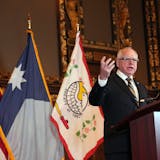Is “The Great Gatsby” really all that great? A year’s worth of events, a slew of new books and a bunch of teenagers in Scotland say “yes.”
The Friends of the St. Paul Library already has kicked off a year of events to celebrate the 100th anniversary of “Gatsby.” The book has been in the “great American novel” conversation for eight decades, and Friends’ Alayne Hopkins says they’re interested in why people never stop talking about it.
St. Paul native F. Scott Fitzgerald’s novel is about a remote millionaire named Jay Gatsby, who engages in a doomed romance with Daisy Buchanan, runs afoul of her husband, Tom, and leads the antics of his reckless Jazz Age buddies.
“It’s looking at class and social inequality. Racism, certainly, is addressed in the novel, along with that kind of associated ‘otherness.’ And the position that women had in society,” said Hopkins, senior director of programs and services for the Friends. “All of those sorts of questions exist today.”
That’s probably why “Gatsby” seems to be everywhere — along with the fact that it came into the public domain a few years ago, meaning it’s open season on its story and characters. There’s a musical version currently on Broadway and “Gatz,” a six-hour adaptation of the book that previously played at Walker Art Center, will appear off-Broadway this November. There’s a new graphic novel version and numerous “sequels,” including the upcoming “The Gatsby Gambit,” in which the title character’s sister solves the murder of everyone’s least favorite Gatsby character: wealthy, boorish Tom Buchanan.
Clearly, we are still pondering “Gatsby.” Which is why the Friends wonder, as Hopkins asks, “Does reading ‘The Great Gatsby’ in 2025 give us any new insights? Do we still see ourselves in it? These are questions that hopefully people will be talking about all year.”
That would be nothing different for Mark Taylor. “The Great Gatsby” is his favorite novel and he talks about it a lot, especially when he’s giving 90-minute tours of Fitzgerald sites in St. Paul’s Summit Hill neighborhood. His hope is to give patrons a sense of what it was like for Fitzgerald to grow up there in the early 1900s.
“You really are stepping back in time on the tour because the neighborhood is so well preserved. Obviously, things have changed, but I like to say if we could magically time-travel Fitzgerald to the present day, he’d recognize the neighborhood,” said Taylor. Sites visited include the former home of the St. Paul Academy, where the writer attended school; the University Club, where Fitzgerald socialized; the house where he wrote his first novel, “This Side of Paradise,” and an apartment building where he lived with wife Zelda. “You do get a sense of what it was like for him to grow up here, and I’d like for people to learn more about his life and how St. Paul influenced him, as a person and as a writer,” Taylor said.



